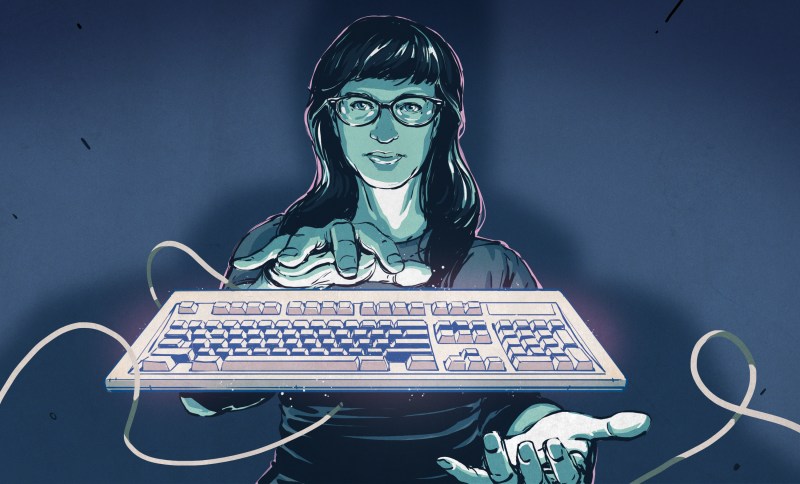
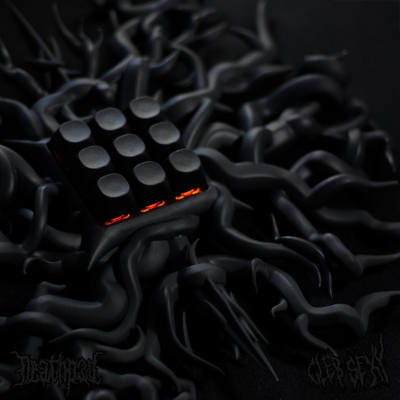 At “the size of three 60% keyboards (put together)” or approximately one Cannibal Corpse record on vinyl, this beautifully-executed death metal font-inspired macro pad by [zyumbik] may be better off hanging on the wall than hanging out on the desktop.
At “the size of three 60% keyboards (put together)” or approximately one Cannibal Corpse record on vinyl, this beautifully-executed death metal font-inspired macro pad by [zyumbik] may be better off hanging on the wall than hanging out on the desktop.
But let’s say you did have room for the 9-key Deathpad on your desktop. Wouldn’t you just play with the tentacles (?) all the time like I would? Yeah, that’s what I thought. They’re pretty inviting.
So why does this look so fantastic? It’s an SLA print, for one thing. For another, [zyumbik] spent over 1,000 hours designing the thing. Unfortunately it’s not open-source, but you can buy the only other one in existence for a cool $1,000.
Rubik’s Cube Keyboard
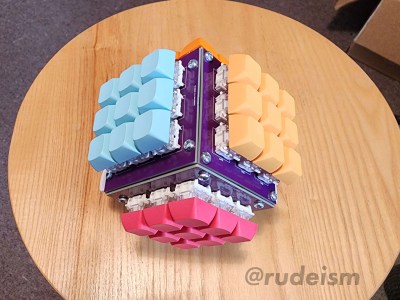 Although it doesn’t rotate (yet), creator [_Rudeism] is calling this the Rubik’s Cube Keyboard. Fine with me, though any type of actual rotation would be insanely difficult to pull off. The plan is to do it with RGB LEDs.
Although it doesn’t rotate (yet), creator [_Rudeism] is calling this the Rubik’s Cube Keyboard. Fine with me, though any type of actual rotation would be insanely difficult to pull off. The plan is to do it with RGB LEDs.
The layout is QWERTY-adjacent — the white side is the num pad, yellow has the modifiers, and the other four sides house all the letters. As you might imagine, this uses a custom frame and PCBs. The switches are Glorious Gateron Clears, which definitely supports the blinkenlights planned for V2.
This thing reminds me a bit of of the SafeType vertical keyboard, or even [Aaron Rasmussen]’s spherical keyboard. Be sure to check it out in Monkeytype action, where [_Rudeism] manages to pull off about 20WPM.
vertical keyboard, or even [Aaron Rasmussen]’s spherical keyboard. Be sure to check it out in Monkeytype action, where [_Rudeism] manages to pull off about 20WPM.
The Centerfold: All Clear Everything
 By now y’all know how much I love clear technology and things. I even built an all-clear ErgoDox, minus the PCBs of course. So it’s only natural that I would choose [HadouKang]’s setup for this issue’s centerfold.
By now y’all know how much I love clear technology and things. I even built an all-clear ErgoDox, minus the PCBs of course. So it’s only natural that I would choose [HadouKang]’s setup for this issue’s centerfold.
That cute little pill organizer of a keyboard is Vault35 with the ortho PCB option, Designer Studio White Jade switches, and MiTo Keysterine keycaps. The ‘buds are Beats Studio Buds+, and the pen is an Opus88 Demonstrator, an interesting fountain pen that one fills with an eyedropper instead of simply drawing the ink up with suction. Finally, dig that ‘lil crab holding up the pen. Doesn’t it just make this whole picture?
Do you rock a sweet set of peripherals on a screamin’ desk pad? Send me a picture along with your handle and all the gory details, and you could be featured here!
Historical Clackers: The Crandall New Model
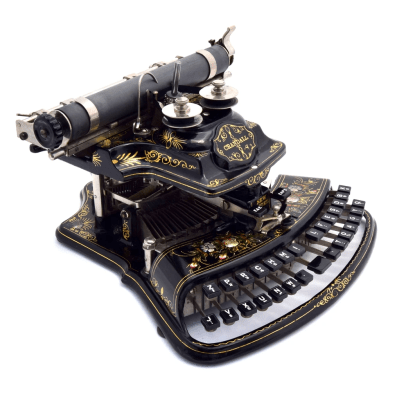
Often cited as the most beautiful typewriter ever produced, I’d have to agree that the Crandall New Model is a sight to behold. Between the mother-of-pearl inlay, floral arrangements, ornate gold embellishments and pin-striping, you’d think it was an expensive sewing machine of the same era (1886-1888).
Most notable beyond the style are the two-row keyboard and something less obvious — the type-sleeve. Instead of individual type bars, the New Model has a cylinder about the size of a finger with glyphs all the way around it. When a key was struck, the cylinder would rotate to the correct position and move up or down as necessary to strike the paper. I think this has to be the inspiration for the typeball in the IBM Selectric.
The awesome thing about the type-sleeve is that you could easily change fonts, which seems kind of mind-blowing for 1886. Speaking of fonts, it’s really, really weird to me how modern those legends look. You’d halfway expect something more flowery, wouldn’t you?
ICYMI: A Raspi Typewriter for the Modern Age
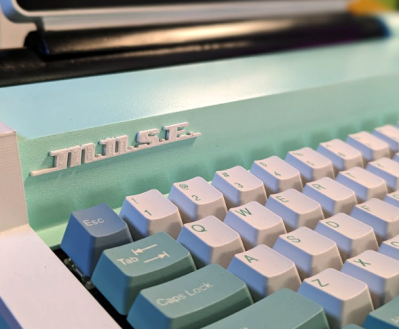 Distraction-free writing is getting harder and harder to come by. Not only is there the pull of life, the computer itself is full of attention-getting alternatives to what one writer called bleeding from the forehead.
Distraction-free writing is getting harder and harder to come by. Not only is there the pull of life, the computer itself is full of attention-getting alternatives to what one writer called bleeding from the forehead.
For [Brendan], there was just one more obstacle to writing the great American novel: the lack of a dedicated machine that would have all the right features. So naturally, [Brendan] took time to whip one up.
The Most Unusual Sentence Extractor, or MUSE for short, is a Raspberry Pi-powered typewriter that saves to the cloud. The design is heavily inspired by the Olympia Traveller de Luxe of the late 1960s and early 70s, and it looks fantastic. I love the logo and the fact that [Brendan] incorporated the LCD touch screen into what would be the platen on an actual typewriter.
Got a hot tip that has like, anything to do with keyboards? Help me out by sending in a link or two. Don’t want all the Hackaday scribes to see it? Feel free to email me directly.
0 Commentaires